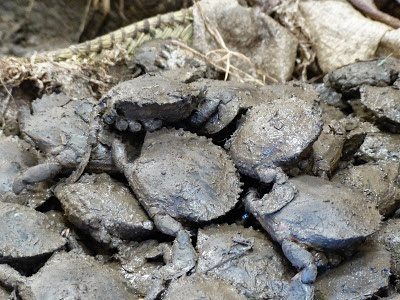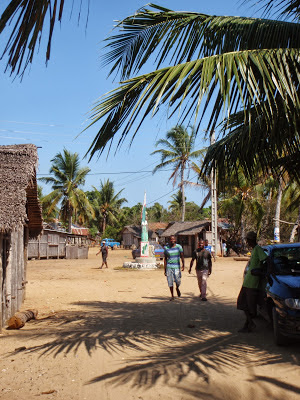This was my fourth trip to Madagascar, but I had never yet been to Nosy Be, a 312 km2 island located 8km off the north-west coast in the Mozambique Channel, and generally considered to be Madagascar's major tourist destination.
Nosy Be means 'big island' in Malagasy, and several smaller islands are located nearby including Nosy Komba, Nosy Mitsio, Nosy Sakatia, and Nosy Tanikely.
 |
| outrigger boat with patched sail |
The first inhabitants of Nosy Be - known at the time as Assada - are believed to have been 15th century Indian and Swahili traders. Refugees, merchants and settlers followed, including British colonel Robert Hunt who in 1649 tried and failed (due to disease and hostile natives) to set up an English colony. King Radama I's wars of conquest led to the Sakalava Boina monarchs seeking refuge on Nosy Be after Queen Tsiomeko's army was defeated. She sought help from the French, and Nosy Be was formally annexed by France in 1841.
 |
| outrigger boat |
As a scuba diver my interest in going there was to dive, as it's considered Madagascar's main diving destination (there are 17 dive clubs located in and around Nosy Be). I've written a separate blog post about diving at Nosy Be.
We chose to stay in a hotel at Madirokely beach, close enough to walk to the main tourist area of Amabatoloaka but not so close that we had any of its inconvenience.
 |
| looking along Madirokely beach to Ambatoloaka beach |
Our dive club was conveniently located just 10 metres behind the hotel, which was very practical.
 |
| Malagasy women walking along Madirokely beach |
Most of our days were spent diving, and on the first outing we went diving at the Marine Reserve of Nosy Tanikely National Park, an island south of Nosy Be.
In between two dives we had 50 minutes to explore the tiny island, which is home to some wildlife and a 10-metre high disused lighthouse.
 |
| skink lizard, Nosy Tanikely |
The lighthouse, which dates from 1908, was still inhabited by a keeper and his family as recently as the 1990s.
 |
| disused lighthouse, Nosy Tanikely |
From the top of the island (only 47 metres high!) you can see Nosy Komba, another island 10 km to the east. Nosy Komba rises to 622 metres - higher than Nosy Be itself.
 |
| Nosy Komba |
 |
| looking down at the beach, Nosy Tanikely |
Although Nosy Be is Madagascar's premier beach destination, it's still fairly low-key, and on Sunday mornings you can see locals bringing zebu for their weekly wash in the sea.
 |
| weekly zebu wash |
On a day off from diving we took a trip around the island.
Our first stop was at an enormous sacred baobab tree where people come to pray to the spirits and give offerings.
 |
| offerings, sacred baobab tree. |
The tree is also home to some black lemurs.
 |
| female black lemur. |
Our next stop was Nosy Be's main town of Hellville. The name has nothing to do with the state of the place; like Reunion Island's Hellbourg, Hellville takes its name from Chrétien Louis de Hell, a 19th century admiral and governor of Reunion Island who annexed Nosy Be in 1841.
 |
| Hellville's old municipal theatre, now the Alliance Française |
The official Malagasy name of the town is Andoany.
 |
| Hellville market |
 |
| inside Hellville market |
 |
| crabs for sale, Hellville market |
 |
| tuk-tuk, Hellville centre |
Like Mayotte and the Comoros Islands Nosy Be is known as the "perfumed isle" due to its cultivation of ylang-ylang, a tree whose scented flowers are much used in perfumery.
 |
| part of the ylang-ylang plantation |
We made a stop at a ylang-ylang distillery where we saw how essential oil is produced from the flowers. It takes 25 kg of flowers to produce just one litre of oil.
 |
| explaining the steam distillation process |
We have a ylang-ylang tree in our garden, so it's a tree I know well, but it's always interesting to see the distillation process.
 |
| some yang-ylang flowers |
 |
| the distillery workers |
After lunch and a few hours spent at one of Nosy Be's few all-inclusive resorts (the only such resorts in the whole of Madagascar), we headed to Mont Passot, which at 315 m is the island's highest point.
 |
| Nosy Tanga island and Djamandjary, Nosy Be's second town |
From Mont Passot there are great views of some nearby crater lakes and out to sea.
 |
| day's end, crater lakes |
After more diving our final day was spent visiting the Lokobe Nature Reserve, which protects most of Nosy Be's remaining endemic vegetation and wildlife.
 |
| Ambatozavavy village |
The visit starts with you paddling your outrigger canoe between the villages of Ambatozavavy and Ampasipohy, the latter being the starting point for nature reserve walks.
Only found in Madagascar, Brookesia is a genus of chameleons that range from small to very small in size, and which are also known as 'leaf chameleons'. It includes the species considered to be the world's smallest chameleon, the Brookesia micra.
Species of lemur at the reserve include the black lemur (which we saw at the sacred baobab; see photos above), the Gray-backed sportive lemur and some mouse lemurs.
The reserve is home to 17 species of endemic bird.
The Brown mantella (Mantella betsileo) is a frog of the Mantellidae family, endemic to Madagascar, and is known locally as Tsirevo.
 |
| Brown Mantella frog |
 |
| a praying mantis |
Uroplatus is a genus of geckos commonly referred to as Flat or Leaf-tailed Geckos, endemic to Madagascar .
 |
| Uroplatus gecko |
 |
| close-up of Uroplatus gecko head |
 |
| cicada |
 |
| green day gecko |
Lokobe also has its own kind of Panther chameleon (a chameleon which is also found on Reunion).
Overall I have mixed feelings about our visit to this reserve. Seeing the wildlife was very interesting, some of which I'd never seen before although I've been to Madagascar several times. However I was surprised to see nocturnal lemurs and lizards during the day - I don't know how good it is for their organisms to be disturbed in this way. The guides seem to use a system of spotters who tell them where such and such an animal can be found, so there's nothing very serendipitous about what you see - the guide knows in advance more or less what you'll see where.
 |
| sunset from Manirokely beach |
If you enjoyed this post you might also like:
- Diving at Nosy Be
- Stone Forest
- Madagascar - Tsingy de Bemaraha
- Ile Sainte Marie, Madagascar
- South-west Madagascar


















